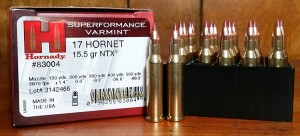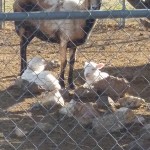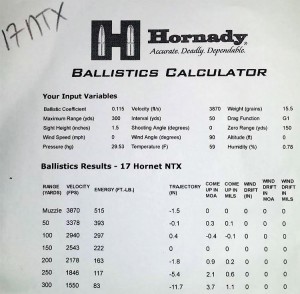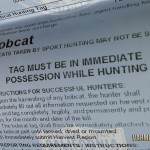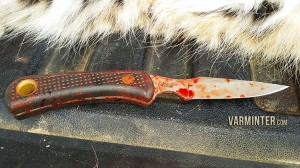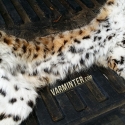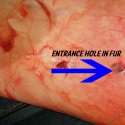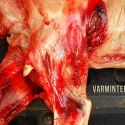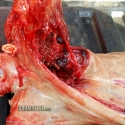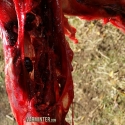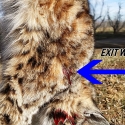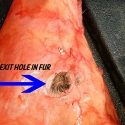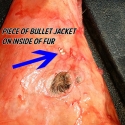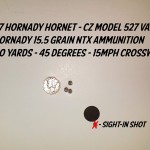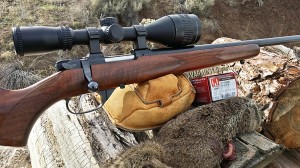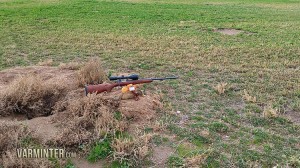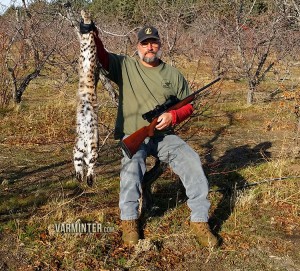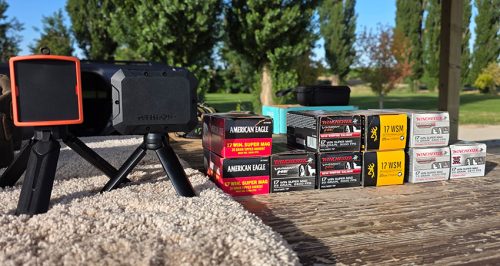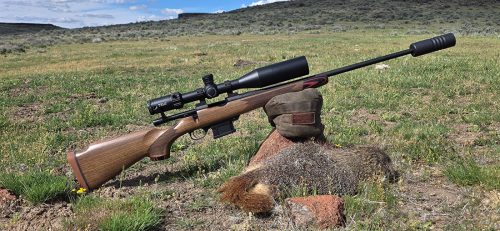Up until a few weeks ago, the only ammunition you could find with Hornady’s .172 caliber, 15.5 grain NTX bullets was in 17HMR or 17HM2 rimfire ammunition. I received an email from one of the online retailers I buy from, that they got some of the new Hornady .17 Hornet ammunition in, with the 15.5 grain NTX. Although it was listed in Hornady’s catalog, I did not think it would be released so soon after the great ammunition drought of 2014. Finally, there was some good news for us folks who have to hunt in lead free areas here in California and elsewhere. Relieved to find that the price was nowhere near the $50+ MSRP Hornady had listed on their website, I ordered 5 boxes at around $20 a box, and started planning a short hunt trip to test out the ammo.
17 Hornady Hornet NTX Lead Free Ammo Review with Bobcat Hunt
Watch the Video Portion of the Review and the Bobcat Hunt on Video Here:
It was a few days before the ammo was to arrive when I received a phone call from one of the farms I hunt in the lead free zone here in California. Apparently, one of their goats just gave birth to twins and various predators were starting to show up in the area in larger numbers than normal. Because he was already missing a couple of farm cats, the ranch manager was concerned that his two kid goats might be killed. You may hear some anti-hunters say that predators only kill rodents, but when I find scat with yellow and white hair from a tabby cat, or feathers from a guinea hen, I know that to be completely false. Predators are opportunity killers and will do so whenever they get a chance. I told the ranch manager that we would be up soon to help resolve his predator problem.
When the ammunition showed, I took some pictures and posted one on the Varminter Magazine Instagram page. They didn’t look much different from the original 20 grain offering Hornady put out a couple of years ago. I did notice that they were listing the speed of the 15.5 grain NTX as 3870, this was a couple of hundred feet per second faster than the 3650 feet per second listed for their 20 grain VMax lead bullet offering.
The morning of day one found me up in the lead free zone as the sun was coming up over the mountains. The evening before I left, I ran some numbers using the 3870 feet per second number provided by Hornady, to set-up a ballistic table for the new round. Rarely do the numbers provided by manufacturers come close to real world results, but when I shot the Hornady factory 20 grain VMax 17 Hornet rounds last year, I found that they were only about 50 fps off the listed 3650fps. Because my CZ 527 also has a 24″ barrel, I assumed the listed speed would be close enough for now, so I used the 3870fps number. With a 150 yard zero, it put the bullet 0.1″ low at 50 yards, 0.4″ high at 100 yards, dead-on at 150 yards and only 1.8″ low at 200 yards (see below).
After the quick sight-in, I picked-up my cameraman, Tom, who was going to be the shooter this morning. He had just picked-up a bobcat tag and was hoping to fill it while I captured the shot on video. However, we both knew that it didn’t matter what showed up first, coyote or bobcat, our job was to remove them from this ranch. As we slowly walked through the trees, we caught sight of something moving through the trees, away from the area where the livestock was kept. As we strained to see what it was, Tom hissed “bobcat”! As Tom readied the rifle, we began to parallel it while it moved east. Then, just as we were getting close, it disappeared. We kept moving, very slowly, until we rounded a large tree and saw the bobcat walking directly away from us down one of the rows. I got the camera ready and gave Tom the okay to shoot when he had a broadside shot, but the bobcat wouldn’t turn. It kept walking away and I began to realize that the opportunity might be lost in a matter of seconds, so I cut loose on some crying sounds, until it finally turned, looked right at us and stopped, broadside! Tom had the rifle up and I was thinking to myself, “shoot”. Right as the bobcat raised his foot to walk out of the row, the crack of the .17 Hornet went off and I watched it drop on the video camera’s screen. It was dead before it hit the ground. I immediately said, “Great shot!” to Tom, as we finally got a moment to breathe. I knew it was dead, but Tom wanted to head out and check to make sure. While he did so, I got some video of him walking to the spot where it dropped, at 75 yards away.
As I approached the bobcat, I could see the white of its belly fur and the black spots that peppered it. Normally bobcat in this area have a creamy white to their bellies, but this one was a nice, bright white, with deep, dark black spots. It had a gorgeous fur! After we moved to another area, we took some pictures and I finally got a chance to check out the exit wound. I saw fur puff out of the bobcat on the video camera when the bullet hit, so I wanted to make sure there was not a lot of fur damage. We got it hoisted up to begin the process of skinning it and as I pulled the the fur down past its shoulders, I started to see the extent of the bullet damage to the bobcat’s body. The entrance hole was small, but everything between that hole and the exit hole was completely devastated. The bullet had entered the left leg/shoulder, blown up, broke the left leg, then it passed through the heart/lung area, exiting the right side. Although there was a lot of damage to the bobcat’s body, the fur had nothing but a tiny entrance hole and a dime-sized exit hole. It made for a quick and easy skinning job, with the bullet performing as I had hoped.
I am including detailed pictures below, some of which may be graphic, so those who hunt predators with this round can see the actual bullet performance.
After taking care of the bobcat, I finally got a chance to shoot more at the bench. I first sighted-in at 50 yards and while doing so, I noticed a large, brown lump on a mound way out past my target set-up. I checked with my binoculars and realized it was a fat ground squirrel catching some sun while sitting out on its mound. I hit the mound with my rangefinder and got a reading of 187 yards. I adjusted my Hawke Panorama scope to put him just below the center hash line. I squeezed the trigger and heard an audible “thump” as I watched it get thrown from the top of the mound through the scope! I let it lay for a bit while I shot a few more rounds, then headed over to the ground squirrel. It barely had any blood on the entrance side, but there was a small amount of innards laying out of the exit side. I had seen this type of wound before, when I was using the Hornady 17HMR loaded with the same 15.5 grain NTX bullet. The one major downside to this bullet was the less-than normal expansion that I am used to when I use lead bullets. I wasn’t too concerned, as my main focus was on accuracy, with bullet performance determined to be good if it killed the varmint quickly. These bullets did just that, as the squirrel was laying exactly where I saw him land after the shot. He was dead instantly, likely never knowing what happened.
The next morning I awoke in my trailer to a cold wind and cloudy skies. We headed out looking for predators and played a cat and mouse game with a wily coyote who would not offer me a shot. Since I had to hit the road early, I packed everything up and headed up the road to another farm I shoot. There was a spot where I could sight-in again, while waiting to see if any ground squirrels showed up on an old wood pile next to an alfalfa field. The ground squirrels cause a huge amount of destruction on this particular farm, with the owner always asking us to shoot as many as we can. When I pulled into the spot, there was a stiff wind coming from the west, that I estimated to be around 15mph. I took this into consideration as I set-up my shooting platform and waited to see if a ground squirrel would pop-out. Sure enough, a few minutes later, I could see a ground squirrel moving through the pile of wood, working its way to the top of the pile. However, whenever the sun disappeared behind a cloud, he would disappear back into the depth of the pile. My guess was, he probably thought the shadow was a winged predator and he was doing a bit of self-preservation. Right about the time I was about to give up, he climbed out into the open, offering me a clear shot. I chambered a round and found him in my scope. I had already lasered the pile and it was 87 yards away, so it was a matter of pushing off the safety and making the shot. At the crack, he was lifted off the branch and landed a bit less than a foot away. After closer inspection, the bullet had found its mark and again exited the opposite side, pushing out some of the ground squirrel’s innards. He was also dead instantly from the 15.5 grain NTX bullet out of the CZ .17 Hornet.
I continue to be impressed with Hornady’s lead free, factory ammunition. This .17 Hornet ammunition is one in a line of ammunition offered with the 15.5 grain NTX bullet. I have tested both the 17HMR and 17HM2 (17Mach2) ammunition loaded with this same bullet and they, too, were accurate in the majority of my rifles. Although I am glad that the .17 Hornet now has a lead free factory load, reloaders have been begging Hornady to release the 15.5 grain NTX bullet as a component so those of us who hunt in lead free areas of the United States, could load for all of our .17 caliber centerfire rifles (in particular, California, which is about to go 100% lead free in a few years). In the meantime, I would not hesitate to buy some of the loaded Hornady .17 Hornet 15.5 grain NTX rounds to use in areas that require lead free bullets.
- A Unique Rifle – CZ Model 527 in .20 Hornet Ackley Improved - November 25, 2025
- My Favorite New Factory Rifles of 2025 - October 28, 2025
- Winchester XPert Rifle in 17WSM – A Summary of an Upcoming Review - September 16, 2025

